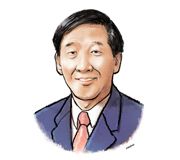Small firms need to overcome Peter Pan Syndrome
Small Korean firms are trapped in what resembles the Peter Pan Syndrome or Dwarf Syndrome, where adults do not want or feel unprepared to grow up. In the Korean economy, this tendency can be seen among small- and medium-sized firms that fear to become large companies.
Since the 1980s, the number of large firms the size of Samsung, Hyundai, LG and SK has not increased. Further, there are currently only 1,422 medium-sized firms, making up less than one percent of all companies in the country. In 2011, 111 medium-sized firms broke into smaller firms in an attempt to benefit from various government funding programs.
The public isn’t aware of this problem because the Korean media fails to cover news about the overprotection of small firms. For instance, headlines seldom mention large firms being divided into small ones to keep government subsidies. The media encourages government support for small firms and portrays small companies as victims of conglomerates. Similarly, the National Assembly is sometimes blindly bipartisan in increasing financial, institutional and regulatory support for small companies.
This problem among small companies may stem from the government’s criteria for qualifying for support. For instance, in order to obtain support, firms must keep employees below 300 and capital below $8 million. Once employment and capital surpass these figures, a company will no longer be eligible for 160 support programs. Further, once a company’s assets surpass $5 billion, it will face various investment restrictions.
“Korea has the world’s best support program for small companies. Small firms enjoy credit guarantees, subsidized loans, tax deductions and partial exemptions for hiring people with disabilities,” according to former chairman of the Financial Supervisory Commission Chin Dong-soo. Policymakers and scholars of many developing countries regard Korea a good model for small business support programs.
However, many business experts, including chairman of the Korean Association for Medium-Sized Companies Kang Ho-gap, believe this system needs to change. He related his own company’s experience in order to emphasize the need for change. According to him, his company barely survived bankruptcy while transforming from a small- to a medium-sized firm. He said he was unable to borrow additional money for investment when his employment and capital surpassed 300 and $8 million.
Policymakers need to check the effectiveness and efficiency of business support programs, as overlapping and uncoordinated programs waste money and hamper the growth of medium-size firms. Kang says that the government should not eliminate support for small businesses, but rather provide one that helps medium-sized firms become large companies.
Small Korean firms need to grow and become globally competitive, as they account for 99 percent of companies. Further, since these firms comprise 88 percent of manpower in Korea, the country’s employment relies heavily on them. Conglomerates source their production and personnel from different parts of the world, and thus do not significantly expand the job market in Korea.
Germany and Taiwan are two model economies powered by small companies although these countries do not have the comprehensive support programs offered in Korea. It is more difficult to allow small firms to go bankrupt in Korea than in Germany and Taiwan. This is another indication that small Korean firms are overprotected. Overprotection often breeds moral hazard.
Even more problematic is the growing number of self-employed Koreans who represent 15.9 percent of the country’s total employment, and who face financial trouble soon after starting a business. According to Statistics Korea, of the 5.6 million self-employed Koreans, more than half go bankrupt in the first three years. Many of them aren’t eligible for the government’s support program. The government has few tools to curb this growth in self-employed small business owners.
The public as well as President-elect Park Geun-hye believes that small firms need protection and subsidies while large firms need sacrifice and concession. After winning the election in December, President-elect Park met with CEOs of small firms first and then owners of conglomerates. During these meetings, she pledged to support small companies but admonished conglomerates to maintain their manpower.
However, Park should realize the plight of medium-sized companies. There is a more effective and efficient way to narrow the gap and promote a more balanced growth between small and large companies than through extensive support programs. Park should become the first head of state to change the business support programs, in order to encourage medium-sized firms to pursue growth and efficiency. To this end, she could introduce an incentive system for medium-sized firms to become large companies.
She should redefine the concept of the so-called democratization of the economy. This should not involve penalizing conglomerates and supporting small firms. Rather she should devise programs for helping medium-scaled firms become large companies.
Overprotection of small firms is ironically hindrance to medium-sized companies becoming large firms. Park should send a clear message that the government will help small-and medium-sized firms overcome the Peter Pan Syndrome.
Lee Chang-sup is the executive managing director of The Korea Times.Contact him @ editorial@ktime.co.kr <The Korea Times/Lee Chang-sup>




















































